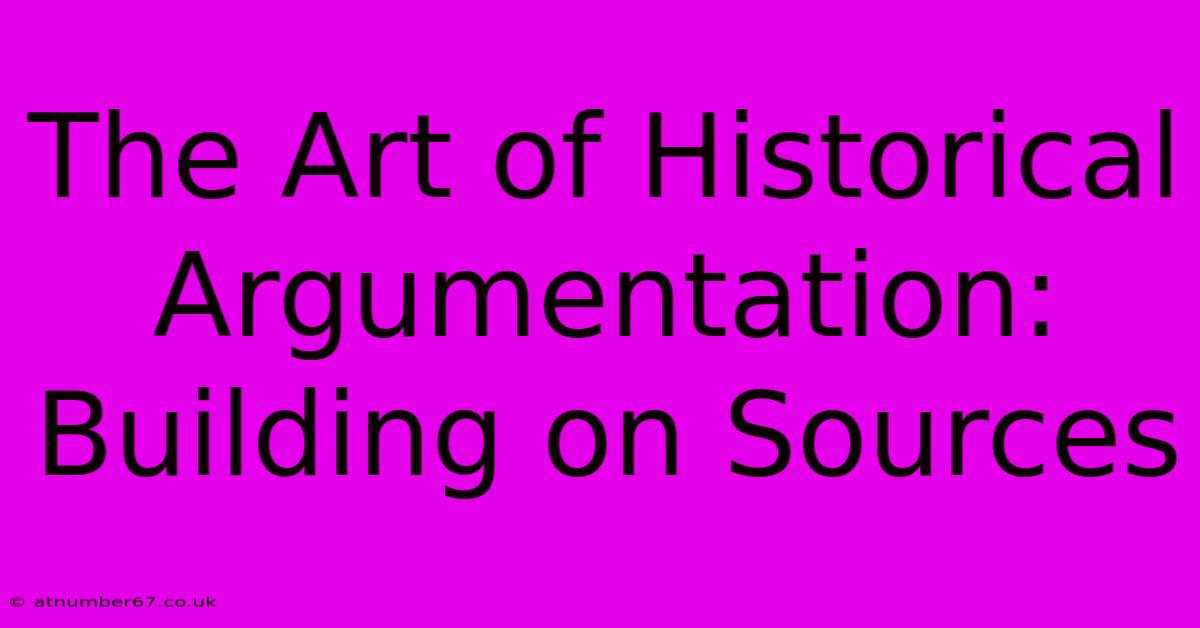The Art Of Historical Argumentation: Building On Sources

Table of Contents
The Art of Historical Argumentation: Building on Sources
History isn't just a list of dates and names; it's a dynamic narrative constructed through careful argumentation. Mastering historical argumentation involves more than simply recounting events; it requires skillfully weaving together evidence from diverse sources to support a compelling thesis. This article explores the crucial role of sources in building a robust historical argument.
Understanding Your Sources: The Foundation of Argument
Before you even begin constructing your argument, you must thoroughly understand the sources at your disposal. This involves more than simply reading them; it necessitates a critical analysis of their context, authorship, bias, and reliability. Ask yourself:
- Who created this source? Understanding the author's background, beliefs, and potential biases is crucial. A diary entry written by a plantation owner will offer a vastly different perspective than a slave's narrative.
- When was it created? The historical context profoundly shapes a source's meaning. A letter written during a war will likely differ significantly from one written during a period of peace.
- Why was it created? The purpose of a source – to inform, persuade, record, or entertain – influences its content and reliability. A propaganda poster will have a different purpose and inherent biases than a census report.
- How was it created? Consider the medium of the source (a letter, a painting, a photograph) and the limitations inherent in that medium. Photographs, for instance, can be manipulated, while letters may be selective in what they reveal.
- What is the source's intended audience? The intended audience affects the language, style, and content of the source. A scholarly article will differ greatly from a newspaper article targeting a broader public.
Building Your Argument: Synthesizing Diverse Sources
Once you've critically analyzed your sources, you can begin to build your historical argument. This involves synthesizing information from multiple sources to support your thesis. Avoid simply summarizing each source individually; instead, aim to weave them together to create a cohesive and persuasive narrative.
Effective strategies for synthesizing sources include:
- Identifying common themes and patterns: Look for recurring ideas, trends, or perspectives across your sources. This will help you develop a more nuanced understanding of the historical event or period you're studying.
- Comparing and contrasting different viewpoints: Acknowledge and analyze differing perspectives presented in your sources. This demonstrates a sophisticated understanding of the historical complexities involved and strengthens your argument.
- Using sources to corroborate or challenge each other: Identify points where sources agree or disagree. This allows you to demonstrate the strengths and weaknesses of different types of evidence and build a more balanced argument.
- Addressing counterarguments: Anticipate potential criticisms of your argument and address them directly using evidence from your sources. This strengthens your overall credibility and demonstrates a thorough understanding of the subject matter.
Examples of Effective Source Integration
-
Instead of: "Source A says X. Source B says Y."
-
Try: "While Source A emphasizes X, Source B offers a contrasting perspective by highlighting Y, suggesting a more nuanced understanding of the situation. This difference may be attributed to..."
-
Instead of: "Source C supports my argument."
-
Try: "Source C's detailed account of [event] corroborates my argument that [thesis], particularly its description of [specific detail] directly supports the claim that [specific aspect of thesis]."
Avoiding Common Pitfalls
Several common mistakes can weaken historical arguments. Be mindful of:
- Over-reliance on a single source: Diversify your sources to avoid bias and present a well-rounded argument.
- Ignoring counterarguments: Acknowledging and addressing opposing viewpoints strengthens your argument.
- Misinterpreting sources: Ensure you understand the context and nuances of each source before using it to support your argument.
- Presenting unsupported claims: All claims must be supported by credible evidence from your sources.
Conclusion: The Power of Evidence-Based Argumentation
Mastering the art of historical argumentation is a crucial skill for any historian. By rigorously analyzing your sources and skillfully synthesizing evidence from diverse perspectives, you can construct compelling, nuanced, and persuasive narratives that shed light on the past. Remember, the strength of your argument rests upon the foundation of well-understood and effectively integrated sources. Through critical thinking and careful analysis, you can transform disparate pieces of evidence into a cohesive and powerful historical argument.

Thank you for visiting our website wich cover about The Art Of Historical Argumentation: Building On Sources. We hope the information provided has been useful to you. Feel free to contact us if you have any questions or need further assistance. See you next time and dont miss to bookmark.
Featured Posts
-
Faiq Bolkiahs Net Worth The Numbers Dont Lie
Apr 14, 2025
-
The Optimists Daughter A Journey Of Self Discovery
Apr 14, 2025
-
The Fascinating Life Of Michael Polansky Age Included
Apr 14, 2025
-
How Ms Dhoni Made His Millions
Apr 14, 2025
-
Die Son Kaapse Nuus The Power Of Cape Town
Apr 14, 2025
